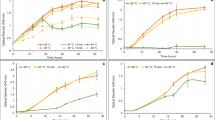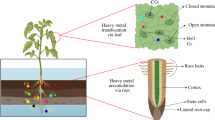Abstract
A mini-hydroponic growing system was employed for seedlings of kudzu vine (Pueraria montana) and contents of isoflavones (daidzein, genistein, daidzin, genistin, and puerarin) from shoot and root parts of seedlings were analyzed quantitatively. In addition, exogenous cork pieces, polymeric adsorbent, XAD-4, and universal elicitor, methyl jasmonate (MeJA), were used to regulate the production of these isoflavones. It was shown that cork pieces up-regulate the production of daidzein and genistein up to seven- and eight-fold greater than the levels obtained for control roots. In contrast, levels of glucosyl conjugates, daidzin and genistin, decrease up to five- and eight-fold, respectively. Cork treatment also induces the excretion of the root isoflavone constituents into the growth medium. Minimal levels of isoflavones are absorbed by the cork pieces. XAD-4 stimulates the production of glucosyl conjugates, daidzin and genistin, in root parts about 1.5-fold greater than that obtained in control roots. These are the highest amounts of daidzin and genistin that are observed (5.101 and 6.759 mg g−1 dry weight, respectively). In contrast to these two adsorbents, MeJA increases the accumulation of isoflavones in shoot rather than in root parts of seedlings, about three- to four-fold over control levels, with the exception of genistein. These studies reveal new observations on the regulation of isoflavone production in hydroponically grown Pueraria montana plants by two adsorbents (cork pieces and XAD-4) and MeJA elicitor.


Similar content being viewed by others
References
Hayashi H, Hiroaka N, Ikeshiro Y, Yamamoto H. (1996) Organ specific localization of flavonoids in Glycyrrhiza glabra L. Plant Sci 116:233–238
Kahl G (1974) Metabolism in plant storage tissue slices. Bot Rev 40:263–314
Kaufman PB, Duke JA, Brielmann H, Boik J, Hoyt JE (1997) A comparative survey of leguminous plants as sources of the isoflavones, genistein and daidzein: implications for human nutrition and health. J Altern Complement Med 3:7–12
Kirakosyan AB, Vardapetyan RR, Charchoglyan AG, Yamamoto H, Hayashi H, Inoue K (2001) The effect of cork pieces on pseudohypericin production in cells of Hypericum perforatum shoots. Russ J Plant Physiol 48:815–818
Kirakosyan A, Kaufman PB, Warber S, Bolling S, Duke JA (2003) Quantification of major isoflavonoids and L-canavanine in several organs of kudzu vine (Pueraria montana) and in starch samples derived from kudzu roots. Plant Sci 164:883–888
Kirakosyan A, Kaufman PB, Duke JA, Warber S, Bolling S (2004) The production of L-dopa and isoflavones in seeds and seedlings of different cultivars of Vicia faba L. (Fava Bean). Evidence Based Integrat Med 1:131–135
Kolattukudy PE (1984) Biochemistry and function of cutin and suberin. Can J Bot 62:2918–2933
Lal A, Warber S, Kirakosyan A, Kaufman PB, Duke JA (2003) Upregulation of isoflavonoids and soluble proteins in edible legumes by light and fungal elicitor treatments. J Altern Complement Med 9:371–378
Strobel J, Hieke M, Groger D (1991) Increased anthraquinone production in Galium vernum cell cultures induced by polymeric adsorbents. Plant Cell Tissue Organ 24:207–211
Yamamoto H, Ichimura M, Ishikava N, Tanaka T, Iinuma M, Mizuno M (1992) Localization of prenylated flavonoids in Sophora flavescens var. angustifolia plants. Z Naturforsch 47:535–539
Yamamoto H, Yamaguchi M, Inoue K (1996) Absorption and increase in the production of prenylated flavanones in Sophora flavescens cell suspension cultures by cork pieces. Phytochemistry 43:603–608
Yamamoto H, Yato A, Yazaki K, Hayashi H, Taguchi G, Inoue K (2001) Increases of secondary metabolite production in various plant cell cultures by co-cultivation with cork. Biosci Biotechnol Biochem 65:853–860
Zhao P, Hamada C, Inoue K, Yamamoto H (2003) Eficient production and capture of 8-prenylnaringenin and leachianone G – biosynthetic intermediates of sophoraflavanone G – by the addition of cork tissue to cell suspension cultures of Sophora flavescens. Phytochemistry 62:1093–1099
Acknowledgements
We wish to acknowledge support for this investigation by the University of Michigan NIH National Center for Complementary and Alternative Medicine grant I P50 AT00011.
Author information
Authors and Affiliations
Corresponding author
Additional information
Communicated by H. van Onckelen
Rights and permissions
About this article
Cite this article
Kirakosyan, A., Kaufman, P.B., Chang, S.C. et al. Regulation of isoflavone production in hydroponically grown Pueraria montana (kudzu) by cork pieces, XAD-4, and methyl jasmonate. Plant Cell Rep 25, 1387–1391 (2006). https://doi.org/10.1007/s00299-006-0198-2
Received:
Revised:
Accepted:
Published:
Issue Date:
DOI: https://doi.org/10.1007/s00299-006-0198-2




